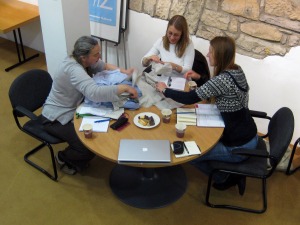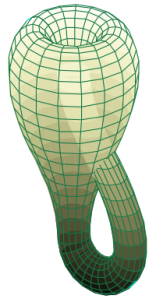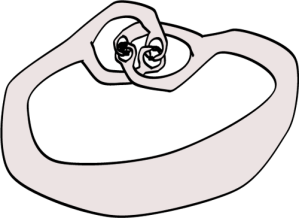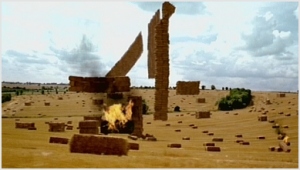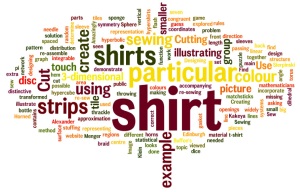The last stitches
The last shirt with the last bits of fabric dying and the last stitches was this one. The fabric has been split and the strands braided then the pieces were attached again to fix the structure.
This was finished not a moment too soon. The work will be hung in the exhibition space tomorrow and will the show will open to the public on Friday 20 January. The venue is a suite of shops in The Saint James Centre, Edinburgh which will house the outcomes of all four projects funded by the ASCUS group. Visit their site for details of the other three projects and, if you’re in Edinburgh city centre, come and see them all over the next five weeks.
Spherical geometry patchwork
This photo shows the patchwork on the spherical curvature shirt. You can see that there’s a lot more machine stitching in this piece. Unfortunately time constraints meant that I had to resort to more brutal methods of joining pieces. The stiffness this imparts is actually quite useful. Piece doesn’t fall quite as flat as it might if it were completely and stitched.
With this one complete we now have our three planes in different types of space – hyperbolic with red heptagons, Euclidan with orange hexagons and spherical with yellow pentagons.
Blackboard shirt
Happy new year, shirt-followers! The gap in posting has been partly due to me being on sick leave for a month and then having to catch up on other work. However the shirts are now progressing again and not a moment too soon! The exhibition of ASCUS funded projects is now scheduled for mid January. More details will be posted here when they are confirmed.
As well as exploring mathematics itself, we decided to represent the collaborative process of mathematics. We are preparing two shirts based on the iconic tools of the mathematicians trade, the blackboard and the whiteboard. Mathematicians don’t just use boards for teaching. Ideas are written up to consider privately and with colleagues. The contents of these boards are essentialy ephemeral. Things get ammended, refined and perfected then rubbed out. We have tried to preserve snapshots of this culture.
Images of blackboards were printed on silk and bonded to a black shirt. Relevant text and equations were then hand-embroidered by Julia and I finished the boards with machine stitched grey frames.
For the whiteboard shirt, Julia took a white shirt and a set of fabric dye pens into the School of Mathematics at University of Edinburgh and asked her fellow mathematicians to write examples of current research and open problems directly onto the shirt. After fixing the dyes, I plan to pick out some of the writing in stitch. We’ll have photos of that one shortly.
Shirts in lectures!
All the hexagons that Madeleine and I cut out during the Stitch Lounge have now been assembled into their patchwork form! I have to thank my friends who’ve been putting up with me doing sewing at every social event, and the television series Castle for providing me with many hours of entertainment whilst stitching. A photo of the final finished piece will have to wait until the exhibition!
Now it’s time for me to get started on the heptagons for our hyperbolic shirt…
In other news, I got to use our Klein Bottle shirt design to make an emergency Klein Bottle for a lecture yesterday. Undergraduate students were learning how to construct new topological spaces from old ones, and one example of this is that you can construct a Klein Bottle by gluing the edges of a square in a particular way.

Glue the two red sides (arrows matching) to get a cylinder, then match the blue sides & arrows to get a Klein Bottle
From these instructions it’s pretty hard to see what a Klein Bottle could look like, but it can easily be made with a shirt by turning one sleeve inside out, passing through the front of the shirt and then pinning the two cuffs together. Great to see that The Mathematician’s Shirts is having a good effect on my teaching as well as on my stitching abilities!
Shirt shredding
This shirt is one of three donated by Helen Frossling of the International Centre for Mathematical Sciences. The photo shows it being cut in to a strip for knitting into a rope. The rope will still contain all the features that make a recognisable shirt somewhere within it. Once the rope is constructed it will be tied and joined to form a knot nominated by Julia (knots are her speciality :-)). Each of Helene’s shirts will be made into a different knot of some mathematical significance.
I like this set of pieces because I hope they’ll convey the intense involvement that mathematicians have with their research. The shirt is deconstructed in a counter-intuitive way, then reworked twice. Each time the fabric is distorted and entangled while working towards an elegant and unique structure.
Three and a half hours work
On Saturday I spent ages cutting papers for traditional patchwork. The will have fabric wrapped around them and basted into place in the traditional manner. Once that’s done, however I plan to assemble the patchwork on the machine. The various polygons will be outlined in stitch – a contrast to the purely hexagonal piece which has been hand stitched, almost invisibly, by Julia!
Making shirts from maths
In my “day job” I deal with mathematical publications and so there are proofs and running sheets galore that are destined for recycling. Being nice quality paper they make ideal paper for hand-stitched patchwork. This weekend I started cutting them up to make the second of out curvature shirts. In this picture you can see my cutting mat, the running sheets, the patchwork grid ruler, a plastic pentagon template, some cut papers and a neat little finger scalpel that’s kind to my arthritic knuckles.
The pentagons will be made up in yellow fabric and will form a part of a patchwork extension to a shirt, much like the one in the previous post. The yellow pentagons will replace the orange hexagons and the shape will change as a result. The final stage is to make a similar piece with red heptagons (7 sides, like a 50p piece) and you’ll see how this changes the shape again.
Last week we made great progress with the Klein bottle shirt. Julia came up with a smart way of connecting the parts of the shirt to get the right shape. With a combination of hand and machine sewing we got it almost finished. parts of the shirt have had wire inserted to hold it in shape. This one won’t be fully completed until we see just how it’s going to be displayed – just in case we need to unpick it and change some thing. No pictures just yet as we don’t want to spoil the surprise.
Next week we’ll make a start on the integrable systems shirt – in the meantime our spare hours hold lots and lots of hand cut and stitched patchwork!
Stitch Lounge gets us going!
We finally cut some fabric this weekend!
Our three shirts demonstrating different types of curvature will involve a lot of hand sewn patchwork. So we took the opportunity to get stuck in at the excellent Stitch Lounge on Saturday afternoon. It’s an open access sewing workshop at Inspace, in University of Edinburgh’s School of Informatics, that takes place over a weekend. Julia and I met once she’d finished the morning’s Maths Masterclass and come back to town from Heriot-Watt campus.
Stitch Lounge fabric is sponsored by The Cloth Shop, Bonnington Road Edinburgh and they’d provided this lovely shirt-weight cotton in lots of colours – ideal for patchwork. We cut our [very accurate!] paper templates from newspaper and basted the fabric patches around them. All the pieces are then slip stitched together and the papers removed. The paper gives stability to the patches while you’re working. Woven fabric stretches by different amounts in different directions and a hexagonal patch could easily distort as you handle it. Using this method ensures that the only change to the curvature you see in the finished work is due to the different shapes we have inserted in the grid.
[Many thanks to Chris Scott for letting us use his photos on this blog.]
ASCUS progress meeting 1
Last week Madeleine and I met up with Mark Eischeid and Julia Malle from ASCUS to talk about our shortlist of ideas for the project. Mark and Julia are artists from very different walks of life (Mark in landscape architecture and Julia in glasswork) so we were looking forward to getting new perspectives on our ideas from a non-mathematical viewpoint. ASCUS also have the job of finding a venue for our shirty sculptures and we needed to discuss the requirements that some of our sculptures would have. Hopefully we are not being too ambitious!
So, here’s our shortlist of sculptures that we hope to make; indeed, to get started on very shortly!
Klein bottle shirt
A Klein bottle is a famous topological object which has no inside or outside. It was first described in 1882 and only truly lives in 4 dimensions – if we try to draw it in 3 dimensions then it appears to intersect itself. A Klein bottle would be easy to make from a single shirt by passing a sleeve through the main fabric of the shirt and then sewing the cuff to the neck. The bottom of the shirt and the remaining cuff would also be sewn up so that there would be no edges to the sculpture.
Alexander horned sphere shirt
The Alexander Horned Sphere is another great object in topology. Normally when we draw a sphere, there is a clear inside and outside, and if we have a loop of string in either the inside or the outside then we can pull the string tight without encountering any difficulties. The horned sphere is a way of drawing a sphere so that loops of string outside of it cannot be pulled tight. Its invention came as a great surprise to the mathematical community and its construction highlights the crazy properties of infinity and fractals. We would like to make this sculpture using the sleeves of ever-smaller shirts as the ‘horns’, and hope we can do a few iterations before it gets too small!
Patchwork geometry shirts
The discovery of different kinds of geometry came as another surprise to mathematicians. For centuries, schoolchildren had been taught that there are always 180 degrees in a triangle and that Pythagoras’ Theorem is always true. Not so! Triangles on a sphere have angles that add up to more than 180 degrees and triangles in hyperbolic space (like a saddle shape) add up to less than 180 degrees. It is a great lesson in how mathematicians must always be aware of the axioms they build their theories upon. What things do we take for granted now which will be overturned in the next century? Madeleine and I will create these 3 geometries by attaching patchwork shapes to the bottom of the shirts: hexagons fit together to make flat space, pentagons will make a spherical shape and heptagons will fan out to make hyperbolic space.
Illusion shirt
Moving on to a slightly more philosophical work, we would like to create a sculpture which only looks correct from a certain direction. This might mean that it only looks like a shirt from a particular angle, or that a hidden message is seen when it is viewed a certain way. This would illustrate the nature of mathematics: that problems can look incredibly hard until they are seen in the right way and by someone with the right tools. A particular example is in the work of Edinburgh mathematicians in integrable systems, where there are very complex and often chaotic systems of equations, but these can become tractable when transformed into the correct coordinates.
Compressed sensing shirt/image reconstruction shirt
Finally, we had an ambitious idea to create a series of shirts which each had a small piece of an image on them, and the public would have to find a number of the shirts across the city in order to discover the whole image. The implementation could go in two different ways depending on the kind of mathematics we want to showcase. Firstly there is optimization, which tries to spot patterns in order to find relevant data quickly. For example, Google has to sort through millions of web pages every time it does a search, but it is very efficient at knowing where to look. We could implement this in shirt form by placing the shirts in locations with a common theme; for example, all the Tesco stores. A second piece of mathematics we could look at is the relatively new field of compressed sensing. In reconstructing an image this way, mathematicians take advantage of the fact that lots of data is replicated, so that a large image could be reconstructed by just sampling the pixels in a small number of places. We could have lots of shirts around the city, but only a small number of them need to be found in order to put the whole image together.
Our shirt-making will begin on the weekend of the 24/25th September, during an event at Inspace called Stitch Lounge. There’ll be free use of sewing machines, lots of people around experimenting with crafty ideas and, most importantly, afternoon tea. Come along and see what everyone is up to!
And please do leave comments to let us know which sculptures you are most looking forward to seeing, and why. We would love to hear from you!
First brainstorming ideas
On Friday we had our first session of brainstorming mathematical ideas that could be turned into shirty sculptures. Although there wasn’t a good turnout of mathematicians (academics all seem to be away over the summer!) we had lots of ideas emailed to us beforehand so there was plenty to think about.
Take a look at the ideas below and let us know which ones you like best!
– Cut strips into the back of a shirt and braid them;
– Make a Klein bottle shirt by passing a sleeve through the main shirt and sewing up openings;
– Create an Alexander Horned Sphere using smaller and smaller shirts to create the ‘horns’;
– Use seven shirts of different colours and sew them into a torus to demonstrate that 7 colours are needed so that no two regions of the same colour touch;
– Sew shirts into a network or graph, illustrating a particular problem. For example, making a thrackle and designing an accompanying flash game on this website;
– A hyperbolic shirt, sewing in extra material to the hem or sleeves;
– Design a pattern on the shirt which can only be seen when viewed from a particular angle, illustrating work done on integrable systems where a function only looks linear when transformed into the correct coordinates;
– Sew shirts together to incorporate a particular group structure or symmetry, for example the dihedral group;
– Create a ‘hypershirt’, that is, a 3-dimensional representation of a 4-dimensional hypercube;
– Cut a disc out of the front of a shirt and re-sew to illustrate a solution to a puzzle (how to tile the disc with congruent tiles so that at least one tile does not touch the centre);
– Use stuffing to create a 3-dimensional surface representing a particular statistical distribution;
– Cut a shirt into strips and re-assemble using random rules, for example by throwing dice to determine how many strips of a particular colour are used;
– Find a shirt with widely spaced vertical lines, then sew matchsticks on to find an approximation to pi using Buffon’s needle method;
– Use a t-shirt with a distinctive design and cut parts out of it, asking whether the public can guess what the missing pieces are. Image reconstruction is a big topic being explored by mathematicians in Edinburgh!
– Cut and re-sew a shirt (or shirts) to create a Sierpinski gasket or Menger sponge;
– Cut a shirt into strips and re-assemble into a Kakeya set – a picture which contains a line of length 1 in every direction. Amazingly, it is possible to do this so that the picture has as small an area as you want!








